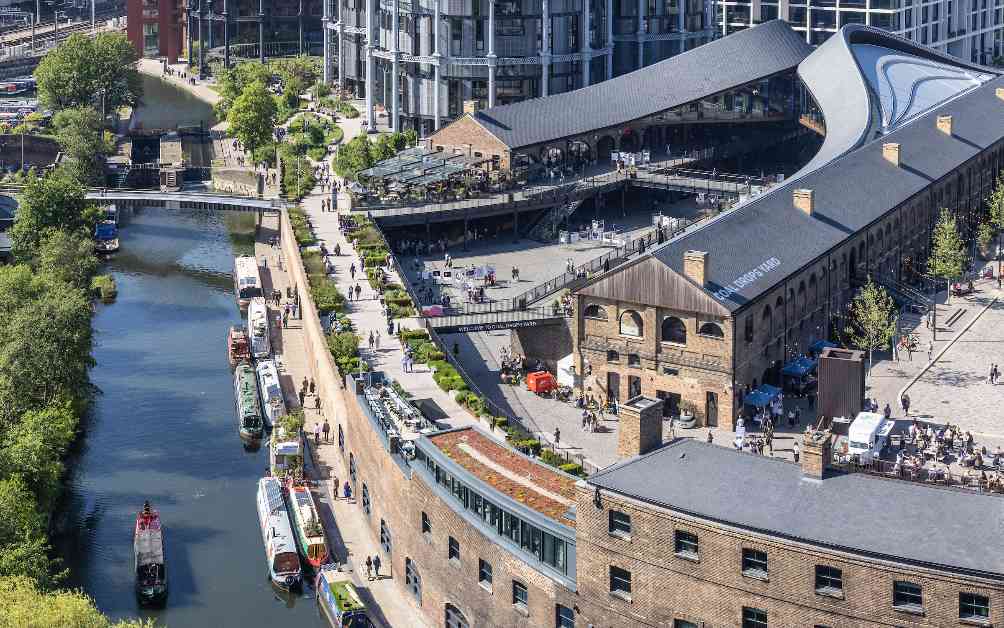King’s Cross Shopping Pavilion Controversy: Residents Left in the Dark About ‘Harmful’ Plans
Residents of King’s Cross are up in arms over plans to transform the historic Coal Drops Yard into a modern shopping pavilion without proper consultation. The developer, Related Argent, has proposed dividing up the grade II-listed coal yard into smaller streets lined with shops and grab-and-go food outlets. However, many residents claim they were not asked for their input on the controversial project.
Coal Drops Yard, designed by renowned architect Lewis Cubitt in the 19th century, holds significant historical importance as a former industrial hub for coal distribution in Britain. The site was redeveloped in 2018 by architect Thomas Heatherwick, featuring innovative ‘kissing roofs’ above the original yard. The proposed pavilion-style building has sparked outrage among some residents, who fear it will detract from the historical integrity of the site and turn it into what one critic described as “a duty-free mall.”
Opposition from Conservationists
The King’s Cross Conservation Area Advisory Committee has been vocal in its opposition to the redevelopment plans, citing concerns about the potential harm it could cause to the area. The committee warns that the proposed pavilion would block views through the yard and diminish the overall aesthetic appeal of the historic site. In a formal letter of objection, the committee criticized the developer for failing to engage with stakeholders, despite claims to the contrary.
While the developer included the committee as a stakeholder in its planning documents, members of the group assert that they were not contacted about the project. This lack of communication has fueled frustration among residents and conservationists who feel their voices are not being heard in the decision-making process. Out of the 33 public responses received by Camden Council during the planning consultation period, only one was in support of the proposed alterations.
Concerns Over Historic Preservation
Numerous objectors have raised concerns about the impact the redevelopment plans could have on the open space and historic value of Coal Drops Yard. Critics argue that the proposed changes could compromise the integrity of the site and diminish its cultural significance. Sir Antony Gormley, the renowned artist behind the Angel of the North statue in Gateshead, is among those who have voiced their opposition to the project.
The controversy surrounding the redevelopment of Coal Drops Yard comes at a time when the King’s Cross area has been recognized for its architectural achievements. Recently shortlisted for the Riba Stirling Prize, the area has undergone a remarkable transformation from a site of abandoned buildings and nightclubs to a vibrant residential area with new homes and public squares. The juxtaposition of modern development and historical preservation has sparked a debate about the balance between progress and heritage in urban planning.
Ongoing Discussions and Community Engagement
In response to the backlash, Related Argent has defended its approach to community engagement, claiming that all listed stakeholders were contacted about the plans. The developer maintains that it is in ongoing discussions with Camden Council regarding the project and is committed to addressing the concerns raised by residents and conservationists. Despite the controversy surrounding the proposed redevelopment, the future of Coal Drops Yard remains uncertain as stakeholders continue to advocate for the preservation of its historical significance.
As the debate over the fate of Coal Drops Yard continues, residents, conservationists, and developers must find a way to balance the need for modernization with the preservation of historical heritage. The outcome of this controversy will not only impact the physical landscape of King’s Cross but also reflect the broader challenges of urban development in an ever-evolving cityscape.





















